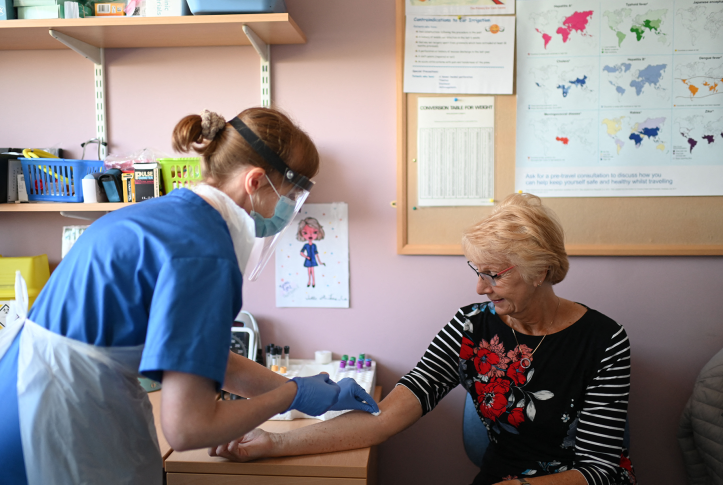A large body of evidence links robust primary care with better and more equitable health outcomes, lower per capita costs, and higher patient satisfaction. Yet, compared with other high-income countries, primary care in the United States lags in terms of access, quality, and comprehensiveness. To address these gaps — and advance health equity — policymakers are looking to strengthen primary care.
How and how much we pay for primary care is central to these discussions. Primary care providers in the U.S. are still largely paid on a fee-for-service basis — meaning they are reimbursed for delivering a limited list of services, regardless of patients’ outcomes. The system creates an incentive to provide a greater volume of care while at the same time restricting the services providers can deliver. In addition, the U.S. underinvests in primary care — meaning that only a small portion of health care spending goes to primary care.
In recent years, policymakers and payers have expressed interest in shifting primary care toward value-based payments, which tie the amount health care providers earn to results, including quality, equity, and cost of care. Experts have called for a hybrid approach to value-based payment that would include fee-for-service payments for high-value but underprovided services (i.e., immunizations) as well as capitation — in which providers are given an upfront payment based on an estimate of the resources they need to care for patients. Advocates of this approach believe that including capitation rewards clinicians for better outcomes and could encourage primary care providers to deliver more comprehensive, equitable, and cost-effective care.
Health needs and the costs of providing care vary between patients and populations. Capitated payments therefore require risk adjustment — meaning that payments are varied depending on an estimate of the cost of treating a patient each year, based on their specific health needs. This risk adjustment is crucial to health equity. Get it right and patients with the greatest need can access critical resources and care; get it wrong and health care provision skews toward wealthy areas, deepening already stark inequalities. The United Kingdom’s flawed risk-adjustment model illustrates the latter and provides important insights for the United States.
When Risk Adjustment Deepens Inequities
Capitation has dominated primary care funding in England for decades. Patients register with a primary care provider who, in return for agreeing to deliver a set range of services, receive a quarterly per-patient payment for each patient in their practice.
Payments are calculated using a formula, called Carr–Hill, which distributes funding by estimating providers’ workload. It primarily uses factors like patients’ age, gender, estimated chronic disease burden, and geography. But the formula fails to include any nuanced measures of socioeconomic deprivation, which are strongly associated with the health care needs of a community. The lack of weighting for social deprivation in the risk-adjustment calculation combined with the relatively high weighting for age — a factor subsequently magnified by the fact that people in wealthier areas tend to live longer — skews capitation payments to practices in richer areas. These deficiencies were pointed out when the formula was introduced in 2004, but fixing the formula has proved difficult. Physicians in wealthier areas have opposed changes, fearing they would lose out and the government has not been willing to provide additional money to “level up” funding.
Inadequate risk adjustment is a major contributor to inequities in provision of primary care in England. Despite significantly higher health needs in poorer neighborhoods, primary care practices in the most deprived 20 percent of areas receive on average 7 percent less funding than those in the most affluent areas. This is because of the emphasis on age and lack of attention to social need in risk-adjustment models. This, in turn, contributes to inequitable workforce distribution, with primary care physicians in the most deprived areas being responsible for the care of almost 10 percent more patients than physicians in the most affluent areas. Practices in the poorest regions of the country perform worse on all major quality indicators, including patient satisfaction.
Getting Risk Adjustment Right
As policymakers and payers in the U.S. move toward value-based capitated payments for primary care providers, the U.K. shows how important it is to get risk adjustment — and payment distribution — right. To avoid underestimating need and the time and cost of providing high-quality care for more complex patients, risk adjustment should account for unmet and under-met need rather than relying on reflections of known chronic disease burden. In the U.S., measures like the Area Deprivation Index and Social Deprivation Index can help identify areas that need additional health resources. These indices are promising tools for payment adjustment, but not universally used.
Shifting to hybrid payment models is a necessary step but not sufficient to improve the equity of health care provision. Addressing the proportion of health care spending directed to primary care overall is also vital, particularly as policymakers ask primary care providers to start doing more, like screening for and addressing social needs of patients, as part of routine care. To harness the power of primary care for advancing equity, payers and policymakers can consider taking steps to ensure that additional funds given to practices are directly used by providers to address the social needs of their patients.
In 1971, British doctor Julian Tudor Hart described the “inverse care law” in health care: those with the highest need often have the least access to good medical care. More than 50 years later, the inverse care law still exists in the United Kingdom and the United States. Efforts to address health inequalities will continue to fail unless the distribution of resources better aligns with the health care needs of patients. The U.S. has a chance to learn from British experience and get risk adjustment right.


